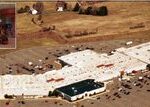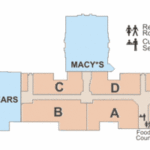Converting a small shopping mall into a hybrid lifestyle center and small shopping mall with no anchor access obviously has been a goal of the ownership of the Lincoln Mall in Lincoln, Rhode Island.
When the mall was built in the mid-1970’s it was originally anchored by Zayre and Woolco and had junior anchors Cherry and Webb, Peerless, and a movie theatre.
While Ames took over Zayres for about four years, it did not last long.
Fast forward ten years later to the mid-1980’s when Caldor replaced the Woolco and Kmart built a shiny and attractive store in the former Ames space.
Despite the fact that both anchors were discount department stores, the mall did well and attracted such stores as The Gap and Lerner.
It was the lone mall in Providence’s northern suburbs until the late 1980’s and had no immediate competition until the Emerald Square Mall opened a few miles away in 1989.
Emerald Square attracted shoppers with 170 stores across three levels and would be just over the Massachusetts border but did not have a great impact on the Lincoln Mall.
Despite this in 1998, the Directory of Major Malls reported the mall still had a four-screen movie theater, Cherry and Webb, food outlets such as Asia Restaurant, McDonald’s, Dunkin Donuts, Papa Gino’s, Newport Creamery, and Roast House.
Stores in the mall also included Spencer Gifts, Hallmark, Things Remembered, Waldenbooks, National Record Mart, Kay-Bee Toy and Hobby, GNC, Lechters, CVS, and Champs Sports.
However, the mall experienced two major blows in 1999: the opening of the larger and more upscale Providence Place Mall in downtown Providence about 10 minutes away and the folding of Caldor when the entire chain went belly-up.
An extensive, mainly exterior renovation occurred in 2000 and despite the loss of many of its junior anchors, the mall rebounded.
Pay/Half moved into the Cherry and Webb space, HomeGoods took over the Peerless space, and the movie theatres were strangely taken over by a medical center.
Most of Caldor was demolished and replaced by a Stop and Shop which had no access into the mall but it did drive traffic to the mall.
Marshalls took over the remainder of Caldor and a small portion of the old mall and was the mall’s eastern anchor.
In 2002, the Smithfield Crossing opened away only a few exits away at US 44 and I2-95 and several stores such as The Gap moved out of Lincoln Mall and into this new large outdoor shopping center which had more of an impact on Lincoln Mall than the other two malls.
The mall was almost fully leased in January 2003.
In 2003, K-mart would close their 110,000 square foot store as part of a round of closings greatly impacted the mall causing stores to empty out at a record rate.
This lead to the mall becoming over 50 percent vacant in February 2004 and hurting the mall even more is the choice of Marshalls to shut down its mall entrance.
At this time, the center was sold to WP Realty who announced plans to demolish much of the mall and replace it with an outward-facing plaza.
Demolition began in late 2004 but the “mall” component is still there.
While most of the western Kmart wing was demolished in 2004, it was replaced by an outdoor strip plaza anchored by a Target.
Target would abut a mall concourse but shut itself off from the mall.
The eastern wing was largely occupied by several large big-box stores such as Marshalls, Home Goods, and a party store.
All of these stores would only have exterior entrances.
Two pieces of the mall’s interior remain including a cross hallway and eastern entrance closest to Marshalls (former Caldor) so patrons can access several stores hidden deep inside the old mall.
The old Marshalls sign above its shuttered interior entrance is still there and the center court area of the mall remains exactly as it always has been.
A mall entrance in the front provides access to the center court with room for about 20 stores.
More than half are vacant despite the recent opening of a Subway.
There are no anchor stores with access to the mall.
The Career Education Institute which moved into a larger space taking much of the interior of the old hallway also does not have mall access.
A large “Cinema World” movie theatre was added to the back of the mall with a mall entrance making the center court act as a sort of movie theater lobby.
If Target removed its wall, the CEI space was removed, and Marshalls removed its wall, about 66 percent of the original mall could be reopened and the stores inside the mall could experience success.
It’s puzzling why the mall hallway was not demolished or that anchor stores were not designed to have both mall entrances and exterior entrances.
In 2001, when the mall management has changed, more stores seem to be closing up inside the mall despite the lack of vacancies for the exterior parts of the mall.
The separation of the “indoor mall” from the “outdoor mall” is actually noted on a Lincoln Mall directory sign in center court which separates the mall into these distinct categories.
According to the Lincoln Mall pylon directory sign along the road, the mall, both indoor and outdoor, currently is occupied by: Target, Super Stop & Shop with pharmacy, HomeGoods, Marshalls, Chili’s, Pay/Half, Ocean State Job Lot (which took over a former supermarket outparcel building), Hollywood Video, Famous Footwear, Starbucks Coffee with drive-thru, Payless Shoe Source, Deb Shops, Dress Barn, Party City, Asia Grill, Radio Shack, and Papa Gino’s.
While the exterior of the mall has one type of architecture, an older type of architectural with skylights can be observed inside the mall, perhaps a lack of poor planning and coordination.
Most of the stores that have mall entrances have exterior entrances.
However, many more only have exterior entrances.
Perhaps the mall should take a page from the book of the redevelopment of East Brook Mall in Mansfield, Connecticut whereas both the inside of the mall and outside has the same design elements.
While that particular mall does have one anchor store, T.J. Maxx, with only exterior access, all of the other stores (both anchor and in-line) have mall entrances including a Kohl’s Department Store (former Caldor then Ames) which has no exterior entrance, forcing shoppers to walk one of two short corridors from a parking lot on either side of the big-box store to access the store’s mall entrance.








